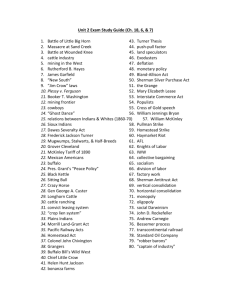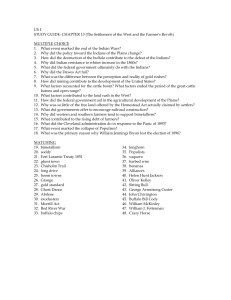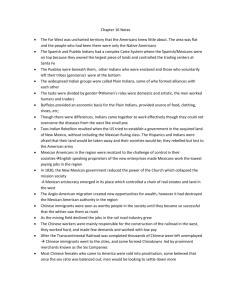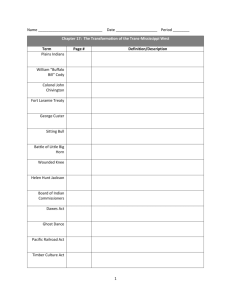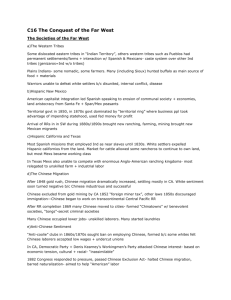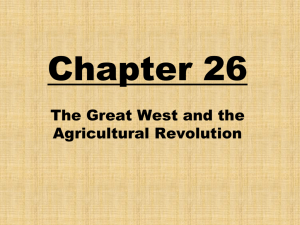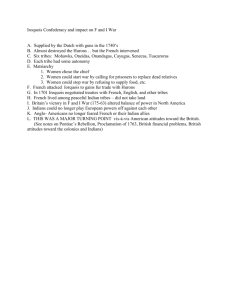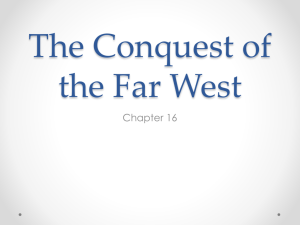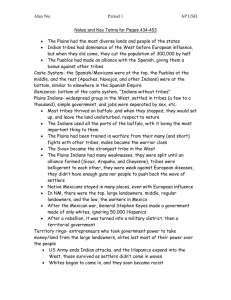The Conquest of the Far West
advertisement
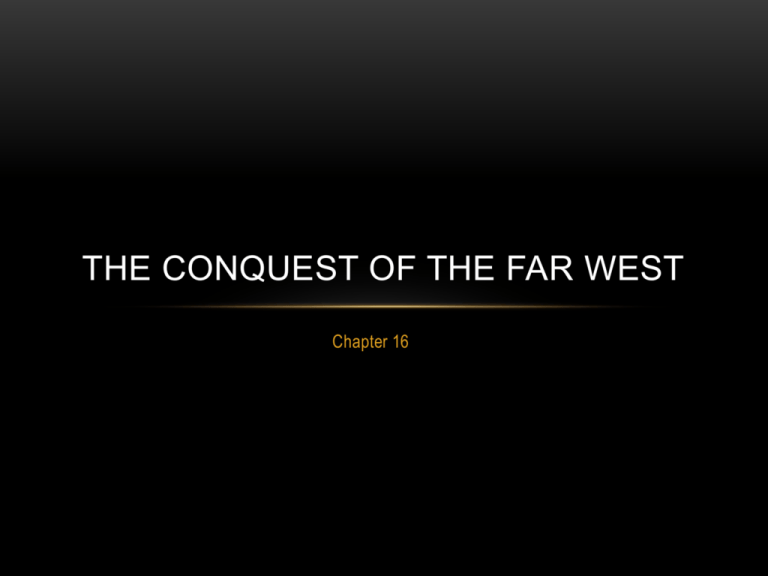
THE CONQUEST OF THE FAR WEST Chapter 16 THE AMERICAN MYTH • What is it? • What is the Myth of the West? • Is the myth the landscape or the people? • England=knights • Japan=Samurai • France=Musketeer • Spain=Conquistador AMERICA= THE SOCIETIES OF THE FAR WEST • West=area west of the Mississippi River • Vast variety of climates, environments, and peoples. • “The West” wasn’t just one thing. THE WESTERN TRIBES Pueblo Indians • Lived in the Southwest • Were stationary, agricultural, corn growers • Built cities of adobe houses • Built complex irrigation systems to water their crops • Allied themselves with the Spanish/Mexicans • Caste System • Spanish/Mexicans—held estates and controlled trade • Pueblos—mostly free, middle class • Apache/Navajos Slaves—lower servant class (Genizaros=Indians without a tribe Pueblo Adobe City PLAINS INDIANS The most populous Indians in the West • Diverse groups of tribes and languages • Some were stationary farmers, other tribes were nomadic • Society based on close and extended family and networks with other tribes • Strong relationship with nature • Tribes divided into “bands” of 500 Indians, each band with its own governing council • Most tribes survived on Buffalo • Skilled and proud warriors • Males were warrior class • These were the most formidable foes whites encountered. The Nomadic Plains Indians Buffalo Hunters PLAINS INDIANS • The Weaknesses of the Plains Indians 1. Inability to unite against White aggression and expansion 2. Inter-tribal conflicts distracted them from the real threat 3. Vulnerable to white/Eastern diseases 4. Economically and technologically weaker than Whites HISPANIC NEW MEXICO • Many Spanish/Mexicans stayed in territories that became the United States as territories gained statehood • Anglo-American encroachment meant opportunity for wealth for some but the end of communal societies and their system of economics for most • When the United States took territorial control of New Mexico, they ignored the Mexican Ruling Class and created a government comprised almost exclusively of Anglo-Americans (Whites) HISPANIC CALIFORNIA AND TEXAS • Most of California and Texas were settled by Spanish/Mexicans or Indians • Missionaries and soldiers were the first White people to settle Spanish California • Missionaries tried to convert Indians and Mexicans to protestant christianity • Soldiers gathered Indians into communities • AS Whites moved in, the social structure of the region changed • Many Hispanics become part of the impoverished working class • Hispanics lost land • Most powerful Hispanics watched as their power dwindled • White ranchers took lands and political power away from Hispanic landowners and farmers THE CHINESE MIGRATION • Chinese were traveling to the United States to find prosperity • After 1849 Gold Rush, Chinese migration to California increased dramatically • By 1880 200,000 Chinese and settled in California • 1/10 of California’s total population • 1850’s Chinese were welcome as the “Most worthy classes of newly adopted citizens” • As Chinese became successful Racism began to grow THE CHINESE LABORER Most Chinese Immigrants worked as Semi-Skilled Laborers like: • Miners of gold—”foreign Miners tax” • Owners of small business • Agricultural Workers • Railroad employees—a variety of jobs • By 1865 • 12,000 Chinese workers worked on the Transcontinental Railroad • Chinese made up 90% of Central Pacific workforce Chinese Railroad Workers THE CHINESE MIGRATION • By 1900 half of the Chinese Population in the US lived in cities • Chinatowns • As the Chinese became a larger part of American culture racism against them also grew • 1882 Chinese Exclusion Act • Banned Chinese immigration into the US for 10—no Chinese let into the country • Banned citizen ship for those already here • Grew from fears that Chinese would cause a labor shortage • Act passed again in 1892, then again in 1902 when it was made permanent MIGRATION FROM THE EAST • Settlers came West in the millions after the Civil War instead of by the thousands before the war • Transcontinental Railroad started brining people west in 1869 • They came for a variety of reasons—like what? • The government helped • Homestead Act of 1862 • 160 acres for almost nothing if the owner occupied it for 5 years and made improvement to the land • Legislators didn’t realize the rising cost of farming • 160 acres was too small for grazing animals (cattle, sheep) • 400,000 used the Homestead act to move West MIGRATION FROM THE EAST • Settlers came West for • Gold and Silver • Pasture lands to raise cattle and sheep • Cheap farmland and high demand for industrial and agricultural crops • But there were problems with the West • Water sources were scarce • People were not well supplied • Indians threatened their safety GOVERNMENT ASSISTANCE TO “CIVILIZING” THE WEST • Timber Culture Act –1873 • 160 more acres if people planted 40 acres of trees • Why would the government want settlers to plant trees? • Desert Land Act—1877 • 640 more acres as long as the farmers irrigated their land within 3yrs • Why would the government want an irrigated West? • Timber and Stone Act—1878 • Sold 1,280 acres for $2.50 an acre for mining and lumber use • Fraud ran rampant • The Federal Government funded local governments with no local tax base THE CHANGING WESTERN ECONOMY • Expansion West was tied to the growing industrial economy of the East • Mining, timber, ranching, farming • The West replaces the South as the prime supplier of raw materials to fuel the Northeast’s Industrial economy • Growth of corporations • Labor market in the West was volatile as need for labor rapidly changed • Mines being emptied of minerals • Farms harvesting their crops • The West had the highest level of single adults in the country • Women find work as household labor (laundry/cooking) or as saloon girls and prostitutes THE CHANGING WESTERN ECONOMY • There was very limited social and economic mobility in the West. • Did this live up to the myth and dream of the West? • Distribution of wealth in the West was the same as in the East • Racially Stratified Working Class • Western working class was very multiracial • White workers occupied upper tier jobs (managers, supervisors, skilled labor) • Non-whites (blacks, Chinese, Mexican/Spanish, Indian) occupied lower tier jobs • A person’s race told employers white type of job they were best suited for ARRIVAL OF THE MINERS • 1860-1890=mining boom in the West • Started with hand or pan mining • • Shallow deposits of gold and silver Corporations • Had the capitol to invest in deeper mining • Usually for quartz and lode (both used for jewelry, industrial abrasives, and cement) • Cities like Denver become large industrial mining towns • Comstock Lode (1859) • Nevada Mine • Produced no supplies of its own, got everything from trains bringing goods from California • Typical of industrial mining towns • Over a ten year period until 1880, the Comstock mine produced $306 million dollars in minerals IN TODAY’S DOLLARS THAT WOULD BE OVER $6,950,000,000.00 MINING LIFE • Mining towns boomed then declined after deposits were mined out • Many mining towns were abandoned after mines closed • These became what are known as Ghost Towns (Barstow California) • Culture in Mining towns was rough • Lawlessness ruled • Almost all the citizens were men • Prospectors came first • Most mining towns mined • Gold, silver, copper, or quartz GENDER IMBALANCE • Men outnumbered woman in mining towns 60 to 1 • Most woman who did live in these towns came with their husbands and engaged in “normal” woman’s work around the home or in some cases outside the home as cooks and laundresses. • Some young, single woman worked as tavern keepers, waitresses, dancing girls, and even prostitutes. THE CATTLE KINGDOM • Open Range • Open grasslands owned by no one that cattle owners used to transport cattle to market (usually St. Louis) and for free grazing (feeding) of their cattle along the way • Was eaten away at by fencing, and farmers • Texas had largest cattle herd—5 million head of cattle • Cattle Industry Needed • Railroads • Cattle trails • Open range • Hard labor—cowboys • Summer and Winters of 1885-1887 killed grasslands and decimated the herds with starvation, fever and illness • Expansion of Cattle industry happened too fast WOMEN IN THE WEST • 1850—250,000 woman owned land in the west • Woman gained political power in the West first • Woman won the right to vote in the West first DISPERSAL OF THE TRIBES • White tribal policies • Federal Government viewed tribes simultaneously as independent nations and as wards of the state • History of the U.S./Indian relationship is one of “endless broken promises” • Concentration Policy • New reservation policy brought on by white demand for land • 1850 • Each tribe given its own reservation instead of one big one • Divided the tribes further • Scatters Indians to undesirable locations INDIAN PEACE COMMISSION • 1867 • Composed of soldiers and civilians • Plan moved all Plaines Indians into 2 large Reservations • Indian Territory (Oklahoma) • Dakotas • Commission tricked and bribes tribal leaders to agree • Bureau of Indian Affairs • Poorly managed, poorly trained, much corruption • Government did not respect Indian life style • Agents of the Bureau focus on white needs DECIMATION OF THE BUFFALO • Starting in the 1850’s whites begin killing buffalo at a rapid rate to feed westward expansion • After the civil war Buffalo hides became a fashion statement and phenomenon • Professional hunters killed for hides and for railroads to clear them out of their way • By 1875 the Southern Herd of eliminated • 1865—15 million buffalo in the US • 1875—fewer than 1,000 buffalo in the United States THE INDIAN WARS • 1850’s-1880’s constant fighting between whites and Indians • US Army and Cavalry became involved in protecting the White people of the West • Conflict between US forces and the Indians insued • Indian Hunting • White vigilanties start hunting Indians for sport • Bounty hunters kill notorious Indians • California Indian population before the Civil War: 150,000— after: 30,000 DAWES SEVERALTY ACT • 1887 • Congress abolished the practice where tribes owned their reservations communally • Split the tribal lands into private ownership within the tribe • 160 acres to each head of the household • 80 acres to a single adult • 40 acres to each dependent child • Act pushed assimilation • Christianity forced into reservations THE RISE AND DECLINE OF THE WESTERN FARMERS • Farmers moved into Plaines region challenging Dominance of Ranchers • Conflict ensued • 1870 farmers • 1870’s-80’s farmers flourished • Farmers started producing too much food, prices fell and the market declined • The Surge • Railroads opened supply chains to farmers, opened markets, and speed, made new areas accessible • Railroad companies became important landowners in the West • Subsidiary lines spread through the West opening expansion and creating many cities and towns PROBLEMS OF FARMING IN THE WEST • Fencing • Farmers begin fencing off the west to control free grazing and identify their property • Very expensive • Creates barbed wire • Irrigation • Water sources other than rainfall • Very expensive • Falling Crop Prices • Credit was easy to obtain but bad crops could leave farmers deeply endebted COMMERCIAL AGRICULTURE • Late 1880’s independent farmers replaced by commercial farming • Industrial agricultural owned by corporations • Cash crops • Sold one crop just money • Farms were not self-sufficient • Made farmers dependent on Bankers, railroads, and markets • World Wide over production created a long period of economic decline for agriculture in the 1870’s-1880’s • By 1900 most farmers were business men who sold their product on the world market which were highly unstable.
